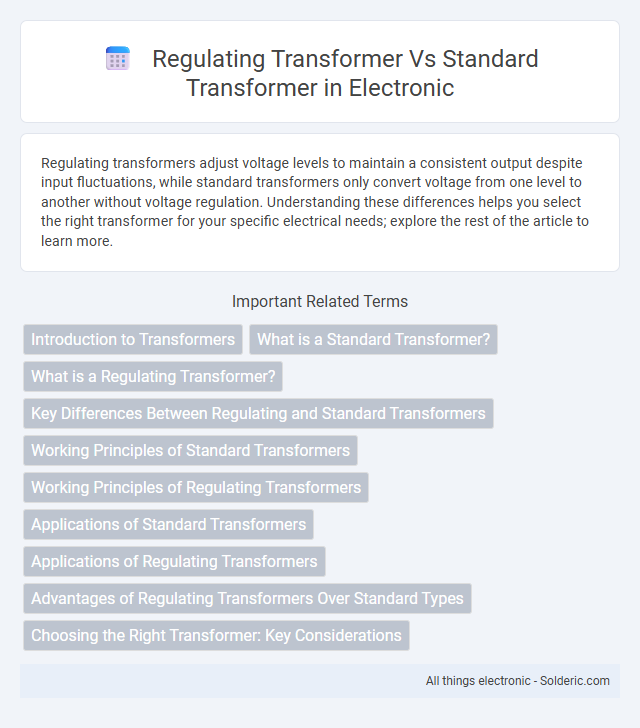Regulating transformers adjust voltage levels to maintain a consistent output despite input fluctuations, while standard transformers only convert voltage from one level to another without voltage regulation. Understanding these differences helps you select the right transformer for your specific electrical needs; explore the rest of the article to learn more.
Comparison Table
| Feature | Regulating Transformer | Standard Transformer |
|---|---|---|
| Purpose | Voltage regulation and control | Voltage step-up or step-down |
| Voltage Adjustment | Continuous or discrete tap changing under load | Fixed voltage ratio, no adjustment under load |
| Load Handling | Operates under varying loads with voltage regulation | Designed for stable voltage output at nominal load |
| Common Types | Tap-changing transformers, On-load tap changers (OLTC) | Power transformers, Distribution transformers |
| Applications | Power grids, voltage stabilization, distribution systems | General power distribution, voltage transformation |
| Cost | Higher due to complex regulation mechanisms | Lower, simpler design |
| Complexity | Higher mechanical and electrical complexity | Simple construction |
Introduction to Transformers
Regulating transformers are designed to maintain a stable output voltage despite variations in input voltage or load conditions, enhancing reliability in sensitive electrical systems. Standard transformers primarily serve to step voltage levels up or down without voltage regulation capabilities, making them suitable for simpler applications. Understanding the differences helps you choose the right transformer for ensuring consistent power quality and system efficiency.
What is a Standard Transformer?
A standard transformer is an electrical device designed to transfer alternating current (AC) voltage from one circuit to another through electromagnetic induction, typically without voltage regulation capabilities. It consists of primary and secondary windings wrapped around a magnetic core, providing a fixed voltage ratio determined by the turns ratio of the coils. Standard transformers are commonly used in power distribution to step voltage levels up or down but do not adjust output voltage dynamically under varying load conditions.
What is a Regulating Transformer?
A regulating transformer is a specialized electrical device designed to maintain a constant output voltage despite fluctuations in input voltage or load conditions, enhancing power quality and stability. Unlike standard transformers, which primarily step voltage up or down, regulating transformers dynamically adjust their tap settings under load to compensate for voltage variations. These transformers are critical in applications requiring precise voltage regulation to protect sensitive equipment and optimize system performance.
Key Differences Between Regulating and Standard Transformers
Regulating transformers differ from standard transformers primarily in their ability to adjust voltage output dynamically to maintain consistent voltage levels despite load variations. These transformers incorporate tap changers or voltage regulators that automatically compensate for voltage fluctuations, ensuring stable power delivery. Your electrical system benefits from improved voltage stability and reduced risk of equipment damage when using regulating transformers compared to standard models.
Working Principles of Standard Transformers
Standard transformers operate on the principle of electromagnetic induction, where alternating current in the primary winding generates a varying magnetic flux in the core. This varying flux induces a voltage in the secondary winding proportional to the turns ratio, allowing voltage transformation without changing frequency. Your understanding of energy transfer efficiency in standard transformers benefits from recognizing that their operation relies on magnetic coupling rather than direct electrical connections.
Working Principles of Regulating Transformers
Regulating transformers operate by adjusting the voltage output through tap-changing mechanisms that regulate voltage levels under varying load conditions, ensuring stable power supply. Unlike standard transformers, which maintain a fixed voltage transformation ratio, regulating transformers continuously adapt to voltage fluctuations by altering taps either on-load or off-load. This dynamic tap adjustment allows precise voltage control, improving power quality and maintaining equipment protection in electrical distribution systems.
Applications of Standard Transformers
Standard transformers are widely used in power distribution systems to step up or step down voltage levels, ensuring efficient transmission of electrical energy across long distances. They play a crucial role in residential, commercial, and industrial applications by providing the appropriate voltage for equipment and appliances. Your electrical infrastructure benefits from the reliability and simplicity of standard transformers in safeguarding voltage consistency.
Applications of Regulating Transformers
Regulating transformers are specifically designed to provide precise voltage control in applications where voltage fluctuations can impact sensitive equipment, such as in telecommunications, industrial automation, and power distribution systems. Unlike standard transformers, regulating transformers adjust output voltages dynamically to maintain consistent power quality, which is essential for processes requiring stable voltage levels. Your equipment benefits from reduced voltage stress and improved performance by utilizing regulating transformers in critical applications.
Advantages of Regulating Transformers Over Standard Types
Regulating transformers provide precise voltage control, ensuring stable power supply despite load fluctuations, which standard transformers cannot achieve. Their ability to maintain consistent voltage enhances the performance and longevity of electrical equipment, reducing downtime and maintenance costs. Your electrical system benefits significantly from the improved efficiency and reliability offered by regulating transformers in comparison to standard types.
Choosing the Right Transformer: Key Considerations
Choosing the right transformer involves assessing load requirements, voltage regulation capabilities, and efficiency levels. Regulating transformers offer precise output voltage control under varying load conditions, making them ideal for sensitive equipment, while standard transformers provide basic voltage transformation with less regulation capability. Consider factors such as voltage stability needs, cost constraints, and application type to determine whether a regulating or standard transformer best suits the specific electrical system requirements.
regulating transformer vs standard transformer Infographic

 solderic.com
solderic.com